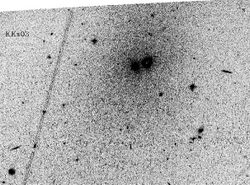Astronomy:KKs 3
From HandWiki
Short description: Galaxy in the constrellation Hydrus
Coordinates: ![]() 02h 24m 44.4s, −73° 30′ 51″
02h 24m 44.4s, −73° 30′ 51″
| KKs 3 | |
|---|---|
 KKs 3 is the dark patch in the centre of this Hubble Space Telescope image | |
| Observation data (J2000 epoch) | |
| Constellation | Hydrus |
| Right ascension | 02h 24m 44.4s[1] |
| Declination | −73° 30′ 51″[1] |
| Apparent magnitude (V) | 14.47[2] |
| Characteristics | |
| Type | dSph[3] |
| Other designations | |
| LEDA 9140,[4] PGC 9140,[5] SGC 022423-7344.3,[4] SGC 0224.3-7345,[5] KKs 3 | |
KKs 3 is a dwarf galaxy in the Local Group. It is unusual because it is gas poor and very isolated in the halo of the local group. KKs 3 is 7 million light years away from Earth. It is categorised as a dwarf spheroidal dSph galaxy.[3] The mass of KKs 3 is 2.3 × 107M☉ (23 million times the mass of the Sun) with a blue absolute magnitude of −10.8.[1] Three-quarters of its stars are over 12 billion years old.[1] Coordinates are R.A. = 02h 24m 44.4s, Dec. = −73°30′51".[1]
It was discovered in December 2014 as a result of the image taken in August by the Hubble telescope.[6]
References
- ↑ 1.0 1.1 1.2 1.3 1.4 I. D. Karachentsev; L. N. Makarova; D. I. Makarov; R. B. Tully et al. (6 November 2014). "A new isolated dSph galaxy near the Local Group". Monthly Notices of the Royal Astronomical Society Letters 447 (1): L85–L89. 11 February 2015. doi:10.1093/mnrasl/slu181. Bibcode: 2015MNRAS.447L..85K.
- ↑ Sharina, M. E; Shimansky, V. V; Kniazev, A. Y (2017). "Nuclei of dwarf spheroidal galaxies KKs 3 and ESO 269−66 and their counterparts in our Galaxy". Monthly Notices of the Royal Astronomical Society 471 (2): 1955. doi:10.1093/mnras/stx1605. Bibcode: 2017MNRAS.471.1955S.
- ↑ 3.0 3.1 Massey, Robert (22 December 2014). "The Milky Way's new neighbour". http://phys.org/news/2014-12-milky-neighbour.html.
- ↑ 4.0 4.1 "LEDA 9140 – Galaxy". SIMBAD. http://simbad.u-strasbg.fr/simbad/sim-id?Ident=LEDA+9140+&NbIdent=1&Radius=2&Radius.unit=arcmin&submit=submit+id.
- ↑ 5.0 5.1 "Object No. 1 – SGC 0224.3-7345". NASA/IPAC Extragalactic Database. http://ned.ipac.caltech.edu/cgi-bin/objsearch?objname=PGC+9140+&extend=no&hconst=73&omegam=0.27&omegav=0.73&corr_z=1&out_csys=Equatorial&out_equinox=J2000.0&obj_sort=RA+or+Longitude&of=pre_text&zv_breaker=30000.0&list_limit=5&img_stamp=YES.
- ↑ Yeager, Ashley (22 December 2014). "Hubble telescope spots our galaxy's newest neighbor". https://www.sciencenews.org/blog/science-ticker/hubble-telescope-spots-our-galaxys-newest-neighbor/.
 |

